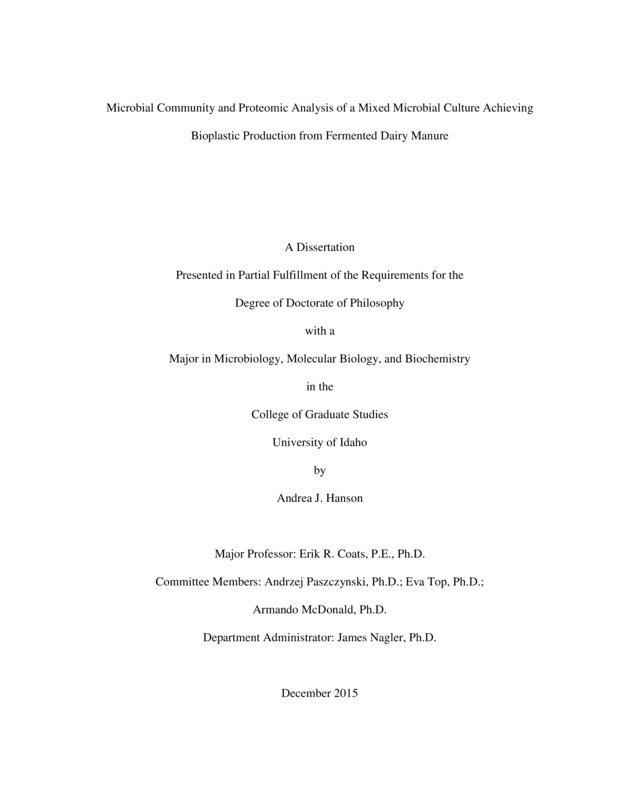Microbial Community and Proteomic Analysis of a Mixed Microbial Culture Achieving Bioplastic Production from Fermented Dairy Manure
Hanson, Andrea Jane. (2015). Microbial Community and Proteomic Analysis of a Mixed Microbial Culture Achieving Bioplastic Production from Fermented Dairy Manure. Theses and Dissertations Collection, University of Idaho Library Digital Collections. https://www.lib.uidaho.edu/digital/etd/items/hanson_idaho_0089e_10742.html
- Title:
- Microbial Community and Proteomic Analysis of a Mixed Microbial Culture Achieving Bioplastic Production from Fermented Dairy Manure
- Author:
- Hanson, Andrea Jane
- Date:
- 2015
- Embargo Remove Date:
- 2017-01-19
- Program:
- Biology
- Subject Category:
- Microbiology
- Abstract:
-
Polyhydroxyalkanoates (PHAs) are bio-based, biodegradable polyesters displaying a range of thermoplastic properties. The use of mixed microbial cultures (MMCs) to synthesize PHA from organic-rich waste streams is an alternative strategy for commercial-scale PHA production. For this approach to be effective, MMCs must be enriched for PHA-producing bacteria exhibiting a physiologically-primed metabolism for PHA storage. Microbial enrichment is commonly performed through the application aerobic dynamic feeding (ADF) or feast-famine conditions in a sequencing batch reactor (SBR), after which the MMC is used for fed-batch PHA production. Our research group has developed a multi-stage PHA production process using fermented dairy manure as the feedstock. However, advancement of this PHA production approach is impeded by an incomplete understanding of the microbial community and functional dynamics associated with conventional process observations. The aim of the research presented herein was to explore the microbial composition and proteome of an MMC enriched through ADF in relation to traditional bulk solution variable assessments. MMC protein mixtures collected over an SBR cycle and during fed-batch PHA production were visualized and compared using two-dimensional electrophoresis. Proteins exhibiting large abundance changes during the SBR cycle and fed-batch PHA production were identified using liquid chromatography coupled with tandem mass spectrometry. For the SBR cycle, prominent functions during the feast phase included PHA synthesis, energy generation, and protein synthesis, whereas nutrient transport, acyl-CoA metabolism, energy generation, and housekeeping functions were more pronounced during the famine phase. During fed-batch PHA production, PHA synthesis-related proteins acetyl-CoA acetyltransferase and phasin proteins were in increased abundance relative to the feast phase, supporting the higher PHA content observed. High-throughput 16S rRNA gene sequencing revealed a diverse microbial community that fluctuated over time, although Meganema was the dominant genus in terms of relative abundance throughout SBR operation. While consistent correlations between microbial composition and the feast-to-famine ratio, specific VFA uptake rate, and PHA content in the SBR were not observed, lower microbial diversity appeared to be more favorable for fed-batch PHA production. Collectively, the results corroborated functional responses of MMCs to ADF conditions and provided new insight into multi-stage PHA production using MMCs and waste feedstocks.
- Description:
- doctoral, Ph.D., Biology -- University of Idaho - College of Graduate Studies, 2015
- Major Professor:
- Coats, Erik R
- Committee:
- Paszczynski,, Andrzej; Top, Eva; McDonald, Armando
- Defense Date:
- 2015
- Identifier:
- Hanson_idaho_0089E_10742
- Type:
- Text
- Format Original:
- Format:
- application/pdf
- Rights:
- In Copyright - Educational Use Permitted. For more information, please contact University of Idaho Library Special Collections and Archives Department at libspec@uidaho.edu.
- Standardized Rights:
- http://rightsstatements.org/vocab/InC-EDU/1.0/

